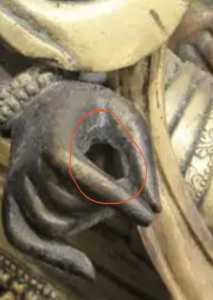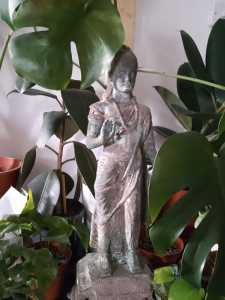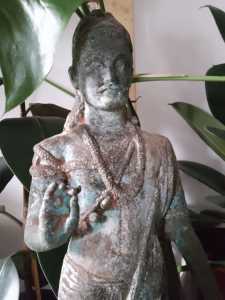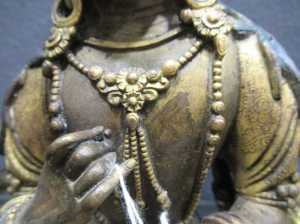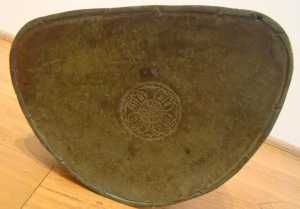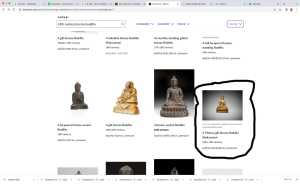The Chinese and Asian Art Forum. For Fans, Collectors and Dealers.
 Basic Rules For the BidAmount Asian Art Forum: Talk about whatever you want. You can even discuss and offer things that are for sale if they are authentic. Maximum image file size per post is 2 MB. Images of 700pxl x 700pxl are optimal if saved at a medium resolution. Be respectful of others and enjoy yourself. Click the YouTube link for a brief tutorial on using the forum. You can also EMBED Videos by cutting and pasting from You-Tube, Vimeo etc.
Basic Rules For the BidAmount Asian Art Forum: Talk about whatever you want. You can even discuss and offer things that are for sale if they are authentic. Maximum image file size per post is 2 MB. Images of 700pxl x 700pxl are optimal if saved at a medium resolution. Be respectful of others and enjoy yourself. Click the YouTube link for a brief tutorial on using the forum. You can also EMBED Videos by cutting and pasting from You-Tube, Vimeo etc.
NOTE: To post an item or add a new post, click open the category title from the FORUM LIST, and CLICK the Blue ADD TOPIC button.
@thomasumjohnson Identifying sand cast has become more difficult in recent years. The fakers often go back and trim/sand the surface areas to to remove obvious faults that occur in casting.
Faults in sand casting include pits, extranious 'dots' of extra bronze, areas of uncarved metal inbetween features. From the photos you've posted, I see a lot of faults in the Qianlong mark - look closely at the 3rd character from the right (Qian). There are 3 'dots' of extra bronze. Other characters also show some 'dots', and overall, the mark has varying degrees of depth. Honestly, the figure would be more convincing as an antique had the maker left the mark off.
With regards to the body features of a sand cast bronze, they are always a bit softer along edges/creases, and shallower. So, when you look at how the robe lays on the body, on a sandcast piece, the robe and body seem as one. Where on a mold cast piece, the crisper lines of the casting cause the robe to look as a seperate piece overlaying the body of the figure.
In fact, in mold cast bronzes, you often can see knife marks in the bronze from when the artist carved the clay model that was used to cast the mold.
The interior of a sandcast piece, which for obvious reasons we did not see for your peice, is usually the dead give away. Sand is always encrusted, sometimes carbonized, into the inner bronze. On mold cast, this simply does not occur and the inner bronze is more refined/smooth (not like the exterior, but notable).
The hand that you have circled not only shows very strange wear to the gold gilt, but there seems to be a loss of the more delicate nature that is very important to Buddhist bronze figures.
@thomasumjohnson it should be mentioned that sand casting was used in ancient times but the technique was used primarily for open works very rarely see any on bronze figures well on older bronze figures and not seen any in earlier Qing. I have circled an area I believe to show sand casting it’s the raised sharp outline if you look at authentic pieces you will notice the hands to be smooth uniform.
Thanks again Brian.. So sand casting doesn't rule out it being C19, also the base isn't cut closed, and in my opinion the bronze looks authentically aged, or tarnished, below the guilting. I personally don't think the wear is un-natural, to my eyes. Usually when I look at a bronze that's un-naturally aged, it is much more obvious. The marks look new, in patches, not an all over wear, as it is in the work in question. Here's a picture of a bronze I have with a simulated patina, probably done with battery acid, a completely different type of aging, but nevertheless.. Does anyone else think the work in question could be C19?
Sand casting in not a 20th century invention.
@lotusblack Brian, can you post some examples of sand cast 19th c. Chinese Buddha with or without Qianlong, marks held by museums, major private collection, or sold through a major auction house? Or, if you have a source that states that sand casting was used by the Chinese in the 19th c. to cast Buddha, could you post that?
Yes, sand casting is not at all a modern technique... a quick Google search dates the technique of sand casting back to the 16th c. However, I'm not aware this was a technique was used by the Chinese for casting Buddha in the 19th c.
I realize a lot of sand cast Buddha have some very good features/details, but I think it is just puffery by fakers, sellers, and auction houses to suggest such pieces are 19th c., but just of lesser quality.
Thomas' Buddha has other issues besides the method of casting that suggests it is a modern piece, but rather than have him chase a rabbit down a hole over the possibility that the piece could still be antique, I'd like to better understand what you are proposing as fact. Thx
@greeno107 I’m not referring to bronze cast figures for sand casting in mid Qing I’m referring to open work only I do own a open work sand casted bronze from Qing Dynasty that was acquired from a museum.
@lotusblack Okay... I'm not familiar with what 'open work' is. Regardless, I just think it is important that while Thomas is hopeful that the Buddha is a genuine antique, that he doesn't cling to the posibility based upon a misunderstanding.
I'd be interested in seeing a genuine sand cast Buddha from the 19th c. regardless of the outcome of Thomas' Buddha... I think it would very interesting to compare differences in casting, but I don't think one exists (at least not Chinese).
Hello
I'm not an expert on bronzes but I love them so I look at them a lot, I also watched this figure when it went on sale recently. In view of the selling price and the quality, it is of course excluded that it is 18th. The Buddhas and similar deities offered at this sale were modern in my opinion.
For this one At best first half of the 20th century but I think rather late 20th with artificial patina, there are many of these modern bronzes and they all have the same finish, patina, gilding.
Best
There are no spikes on the base plate so the helps not date it as 20th century my thinking is 1890ish give or take 20 years
Can you explain what you mean by spikes on the base plate? Sorry, it's probably obvious, just unsure if maybe you mean those hammered notches that hold the base in place, or something else instead.
@craig Not sure if it's true that spiked bases are 20th. Here's a link to a buddha that sold at bonhams for $18,000 that has a spiked base
click on the picture in the link for more photos...
https://www.bonhams.com/auctions/22812/lot/384/
@thomasumjohnson the link seems not to be working what was this listed as? I also cant see the figure. As for the spikes they do use this on most of the 20th century copies these spikes are to hold prayer scrolls or blessings. I have seen them on 19th century figures none on early figures. As for the $18000 that doesn’t make it authentic just pricey.
@lotusblack sorry Brian, Here's the link, says 18th /19th... so I'm figuring some of these had spiked bases..
https://www.bonhams.com/search/?chronology=past&query=A+TIBETAN+GILT+BRONZE+BUDDHA+SHAKYAMUNI
@lotusblack sorry Brian,
For some reason the page won't load on the bonhams site. I've taken a screen shot of the thumb nail. If you manage to open the thumb nail, there are lots of pictures of this buddha. It's easy enough to find on the Bonhams website if you search for 18th century bronze buddha
@lotusblack Brian, I'm not sure if the 'spikes' used to hold the bottom plate onto the figure's base would be a good way to determine age. Looters searching for precious gems often removed the plates and sutra, and a replacement plate may have been added at a later time along with more contemporary sutra, which might have required 'spikes' to fasten.
@thomasumjohnson Thomas, authenticating Buddha requires extensive knowledge of historical depictions of Buddha, as well as understanding the material make up.
I've owned roughly 15 genuine Buddhas, dating from 6th c. Silla period, to late Qing, so I'm not an expert. What I can tell you is that in every case, a near identical example can be found in a museum collection or from a major auction house, sharing similar size, posture, material make up, finish, and quality of the details.
If your piece is different on one (or more) feature of a known comparable piece, most likely you have a more modern reproduction. You can not mix and match features betweeen Buddha of different periods, designs, and construction as a means of authenticating your piece.... it just doesn't work that way. There is no simple rule to follow.
Thanks for visiting "The BidAmount Asian Art Forum | Chinese Art"
If you sell on eBay, or have a shop feel free to post images and descriptions and links.
Check back often for discussion about the latest news in the Chinese art and antique world. Also find out about the latest Asian art auctions at Sotheby's, Christie's, Bonhams and Tajans.
Auction results for: fine porcelain, ceramics, bronze, jade, textiles and scholar's objects. As well as Japanese, Thai, Vietnamese and other Asian cultures.
Thank you,
Peter Combs
Topics and categories on The BidAmount Asian Art Forum | Chinese Art
Kangxi vases, Kangxi dishes and chargers, Kangxi ritual pieces, Kangxi scholar's objects, Qianlong famille rose, Qianlong enamels, Qianlong period paintings, Qianlong Emporer's court, Fine porcelain of the Yongzheng period. Chinese imperial art, Ming porcelain including Jiajing, Wanli, Xuande, Chenghua as well as Ming jades and bronzes.
The BidAmount Asian Art Forum | Chinese Art
A free Asian art discussion board and Asian art message board for dealers and collectors of art and antiques from China, Japan, Korea, Thailand, Cambodia, Vietnam and the rest of Asia. Linked to all of the BidAmount Asian art reference areas, with videos from plcombs Asian Art and Bidamount on YouTube. Sign up also for the weekly BidAmount newsletter and catalogs of active eBay listing of Chinese porcelain, bronze, jades, robes, and paintings.
The art of calligraphy - and for the ancient Chinese it certainly was an art - aimed to demonstrate superior control and skill using brush and ink. Calligraphy established itself as one of the major Chinese art forms during the Han dynasty (206 BCE - 220 CE), and for two millennia after, all educated men were expected to be proficient at it.
The Museum’s collections of Asian art span nearly five millennia and encompass the cultures of China, the Himalayas, India, Japan, Korea, and Southeast Asia. In 2007, the Museum launched an initiative to create dedicated galleries for the collection, beginning with a gallery for the arts of Korea ...
Chinese art is full of symbolism, in that artists typically seek to depict some aspect of a totality of which they are intuitively aware.
China Online Museum is the finest online museum of Chinese art. It features Chinese calligraphy, painting, ceramics, bronzes, carving, and other artworks.
Chinese Ceramics & Works of Art. Overview Upcoming auctions Contacts Auction results ... Christie’s sales of Chinese ceramics and works of art showcase centuries of Chinese history. Held throughout the year in London, New York, Paris and Hong Kong, they attract a wide audience of collectors and connoisseurs vying for pieces as diverse as ...
Explore Asian Art Week. Contact the Specialist Department. Chinese Paintings ... Senior Specialist, Head of Sale. [email protected]. Tel:+1 212 641 5760. Bid in-person or online for the upcoming auction:Fine Chinese Paintings on 10 September 2019 at New York. Bid in-person or online for the upcoming auction:Fine Chinese Paintings on 10 ...
Discover an abundance of must-see art from all corners of a vast continent at Christie’s NY Asian Art Week. From contemporary classical and Chinese paintings to works with exemplary provenance from the Art Institute of Chicago, our Rockefeller Paza galleries will be full of ancient treasures and contemporary masterworks in a salute to the vibrant arts of Asia.
Sold to benefit The Art Institute of Chicago’s Asian Art Acquisition Fund, the sale features 84 lots with a focus on Ming and Qing porcelains, and offers a rare insight into the taste for collecting Chinese ceramics and works of art in the Midwest from the end of the 19th century through the 1980s. Highlights include two Wanli wucai garlic-head vases, a Qianlong mark and period, blue and ...
Specialist, Chinese Paintings, Christie's London Dr Malcolm McNeill is a Specialist in Chinese Paintings at Christie’s, based in London. He previously worked as an assistant curator of the Chinese collections and the Victoria and Albert Museum in London, as a researcher at the British Museum, and as a translator and tour guide at the National Palace Museum in Taipei.
The Christie's Education 2020 Conference: The Chinese Art Market 18 Jun 2019 Christie’s Education is delighted to announce our first international academic conference in Asia which will take place in Hong Kong from 26-27 November 2020 at the Hong Kong Convention and Exhibition Centre and will run in parallel with Christie’s Hong Kong Autumn Auctions.
The summer Chinese Art sale in Hong Kong will feature works of art from several private collections, including Qing porcelains and textile from the collection of the legendary Chinese art dealer A. W. Bahr (1877–1959), fine gilt bronze Buddhist sculptures from an old Hong Kong collection, an East Asian collection of Qing dynasty wine cups and jades, and a Japanese collection of Song ceramics ...
Sotheby's Chinese Works of Art Department holds two auctions each year in London, New York, Hong Kong and Paris.
Chinese Art - View Auction details, bid, buy and collect the various artworks at Sothebys Art Auction House.
With more than 340 Chinese works of art dating from the Neolithic to the Republic periods, highlights of this sale include a selection of Qing Imperial monochromes from the collection of Arnold and Blema Steinberg, early ceramics from the Art Institute of Chicago and Chinese porcelain and works of art from the collection of Henry Arnhold.
Results: Sotheby's Asia Week achieved $52.4 million in six strong auctions, exceeding pre-sale estimates. With 76.5% of lots sold and 60.3% of lots surpassing high estimates, the Asian art sales at Sotheby's indicate continued collector interest in the finest works of art from China, India and and the Himalayas.
Today's sale of Important Chinese Art will proceed as planned with sessions at 10 AM and 2 PM EDT. Sotheby's will be monitoring the weather conditions throughout the day and will be available to coordinate alternative bidding options should conditions make it difficult for clients to attend the auction in person.
Bonhams Chinese Art department is renowned for offering the finest works of art representing the richness and breadth of China's artistic heritage, particularly Imperial porcelain, white and spinach green jades, cloisonné and Buddhist art. Specialised international auctions are held globally, including London, Hong Kong and San Francisco.
Bonhams : Chinese Works of Art We use cookies to remember choices you make on functionality and personal features to enhance your experience to our site. By continuing to use our site you consent to the use of cookies. Please refer to our privacy and cookie policies for more information.
Bonhams Fine Art Auctioneers & Valuers: auctioneers of art, pictures, collectables and motor cars. We use cookies to remember choices you make on functionality and personal features to enhance your experience to our site. By continuing to use our site you consent to the use of cookies. ... Chinese Art (US) General enquiries
Bonhams : Fine Chinese Art We use cookies to remember choices you make on functionality and personal features to enhance your experience to our site. By continuing to use our site you consent to the use of cookies. Please refer to our privacy and cookie policies for more information.
Bonhams Fine Art Auctioneers & Valuers: auctioneers of art, pictures, collectables and motor cars Bonhams : Asian Art We use cookies to remember choices you make on functionality and personal features to enhance your experience to our site.
Bonhams are international auctioneers of fine Chinese and Japanese art. We specialise in rare Imperial and Export Chinese ceramics and works of art, as well as Japanese ceramics, fine and decorative works of art from the Neolithic Period to the 20th century. View on map
Bonhams Fine Art Auctioneers & Valuers: auctioneers of art, pictures, collectables and motor cars. We use cookies to remember choices you make on functionality and personal features to enhance your experience to our site. By continuing to use our site you consent to the use of cookies. ... Asian Art Bonhams. Work. 22 Queen St.
